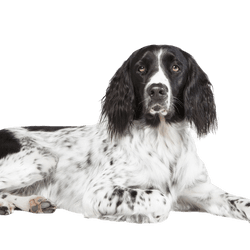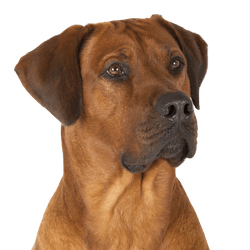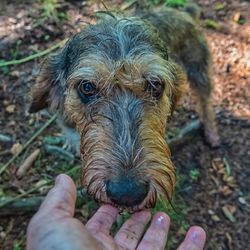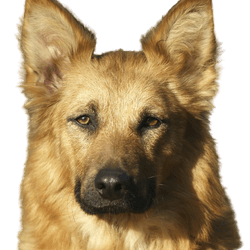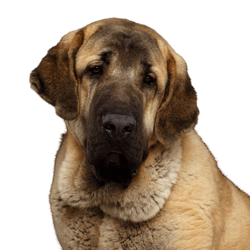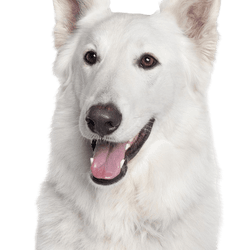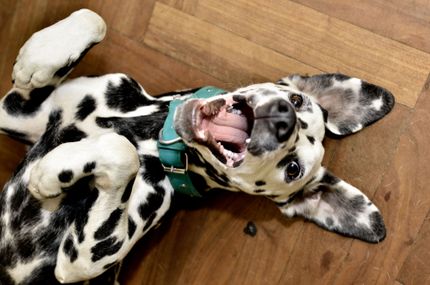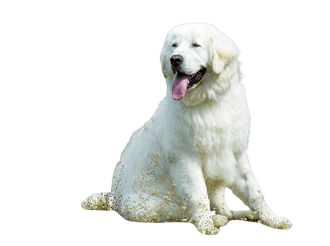
Kuvasz Breed description: Character & Co
Kuvasz
Facts & Origin
What is the origin of Kuvasz?
Historians suspect that the Kuvasz already accompanied Magyars during the migration of peoples in late antiquity. In his "Encyclopedia of pedigree dogs", the famous Swiss cynologist Hans Räber suggests that the Kuvacz was once crossed with the Komondor, also from Hungary, and that the breeds were not separated until around 1900. In the past centuries, the Kuvasz has performed at its best in protecting large flocks of sheep. They courageously stood in the way of predators such as wolves and bears, but also two-legged thieves. With its imposing shape, the Kuvasz scared off almost everyone who tried to intrude. According to tradition, the Kuvasz was also at home at the court of the Hungarian King Matthias Corvinus in the 15th century. Here, it accompanied fine noblemen on the hunt for bears and wolves. In 1905, experts drew up the first standard, which was accepted by the international dog association FCI in 1935. A sad chapter in the history of the breed was the Second World War and the great Hungarian uprising in 1956: at that time Kuvasz almost became extinct. .
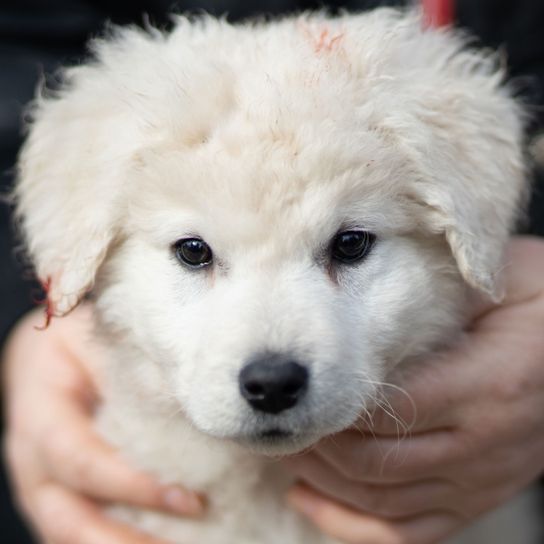



| Alternate Name | - |
| Origin | Hungary |
| Life expectancy | 10 - 12 years |
| Care requirements | low-maintenance |
| Activity level | average |
| FCI group | Sheepdogs |
| AKC group | working group |
| KC group | Pastoral Group |
Attitude, character and temperament of the breed
What are the typical character traits of Kuvasz?
The Kuvasz is an independently acting dog, which had to make its own decisions in the past. Exactly these traits are the reason why a Kuvasz dog is better-suited in the hand of experienced dog owners. As the first one and a half years of their lives shape the character of the animals, you should familiarise your four-legged friend with everything it has to learn during this time. This includes accepting strangers in the house, tolerating noise in the house and valuing the family members as higher ranking. Because one thing is clear: If a full-grown Kuvasz wants to move in a certain direction, you don't stand a chance against them as the person on the other end of the leash. Even with children, it is best to get the four-legged friend used to this at a young age. Because of its size alone, it is not an ideal playmate for small children. It is therefore important gain the animal's respect by treating them with consistency and empathy. The Kuvasz should be kept in a house with a large, fenced-in area. This allows it to pursue its passion, namely protecting its territory. The giant also enjoys going for walks.
Character
Usage


Health and breeding information
What are typical diseases of the Kuvasz?
With the Kuvasz, it is especially important to choose food that is adapted to its age. If the nutrient content is too high, the Kuvasz may grow faster than it should. Problems with the joints and the entire musculoskeletal system are the result. Here are some more health risks:
- Hip joint dysplasia
- Progressive Retinal Atrophy, an eye disease
What should be considered regarding Kuvasz breeding?
In Austria, you can get information about the Kuvasz from the General Shepherd and Herding Dog Club, among others. Lovers buy their Kuvasz puppy from a serious breeder, where they can get to know the parent animals. The expert will competently advise you on the choice of your future family addition and can present papers of mother and father animals. A serious breeder will already expose the young dogs to the first environmental stimuli and thus prepare them for later demands. Before buying a Kuvasz you should also consider that a Kuvasz is certainly more expensive to keep than other breeds. After all, your darling needs more food, and the veterinary costs can be higher. So you better calculate carefully if you want to buy a Kuvasz.


What are the breed characteristics of Kuvasz?
The Kuvasz with its massive body truly makes an impressive appearance. The strong build attracts all eyes. A mane is also typical for males, it is less pronounced in bitches. The black pigmented nose is also typical for the breed. Despite their heavy weight they are amazingly agile and appear rather elegant and not at all clumsy. Often the coat is very tattered, when brushed and groomed, the Kuvasz looks very similar to a Golden Retriever or a white Labrador dog.
Appearance and coat of the Kuvasz
If you are interested in buying a Kuvasz puppy, you should consider that you will end up with a giant in your home later on. You cannot just easily take a dog that weighs over 60 kilograms anywhere. Any transport, be it to a destination or to the vet, requires a big enough car. The Kuvasz is covered with medium-length, sometimes slightly wavy fur. Twice a year, when the coat changes, the animal loses a lot of its dense undercoat. During this time daily brushing is a must to be able to deal with the large amount of hair that will otherwise stick to your furniture and clothes. Even during the year the Kuvasz sheds more than other breeds. It is therefore worth getting them used to grooming their ivory-coloured coat at a young age.
What is the average size of a Kuvasz?
The animals grow to a height of up to 76 centimetres.
How much does a Kuvasz weigh?
An adult Kuvasz can weigh up to 62 kilograms.
What is the life expectancy of a Kuvasz?
They live to about 12 years of age.
| Fur length | medium |
| Fur | - |
| Ear shape | Triangle |
| Tail | fanned out |
| Anatomy | rugged, hefty |
| Size ♀ | 65 - 70 cm |
| Weight ♀ | 35 - 40 kg |
| Size ♂ | 70 - 76 cm |
| Weight ♂ | 45 - 52 kg |
| Suitable For | - |
Colors




Known Diseases
Eye diseases
Often occur with allergies and intolerances.
Hip dysplasia (HD)
The hip dysplasia or hip joint dysplasia of the dog (HD) is a maldevelopment of the hip joint.
Progressive Retinal Atrophy (PRA)
Progressive retinal atrophy (PRA) is a slowly progressive death of the retina in dogs.
Other large dogs
Useful Articles
You can find articles that might interest you in the dogbible blog to match your favorite breed.
Visit our magazineto stay up to date on dog trends.
To find out more, view our Privacy Policy
Find here the breed that suits you and find out what character traits it has. Here you can also learn more about the origin, size and weight of your favorite breeds.
Matching your favorite breed, you'll find articles that might interest you on the dogbible dog blog.
Kennel cough - If your dog coughs, you should know this disease
Real Nature dog food - experience review and is it really that good?
MDR1 mutation - everything you need to know about it if you have a dog
How to introduce dogs and cats - With these 3 tips it succeeds


